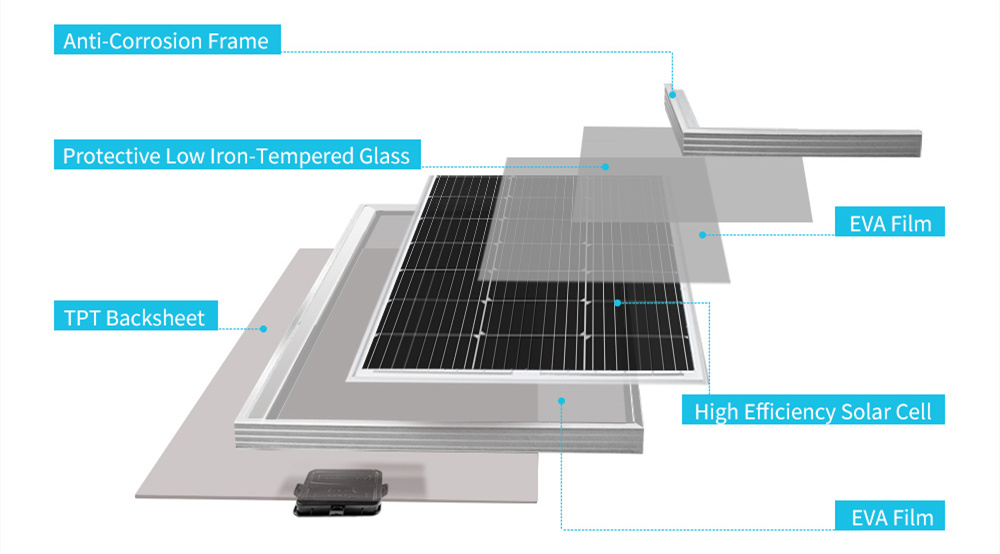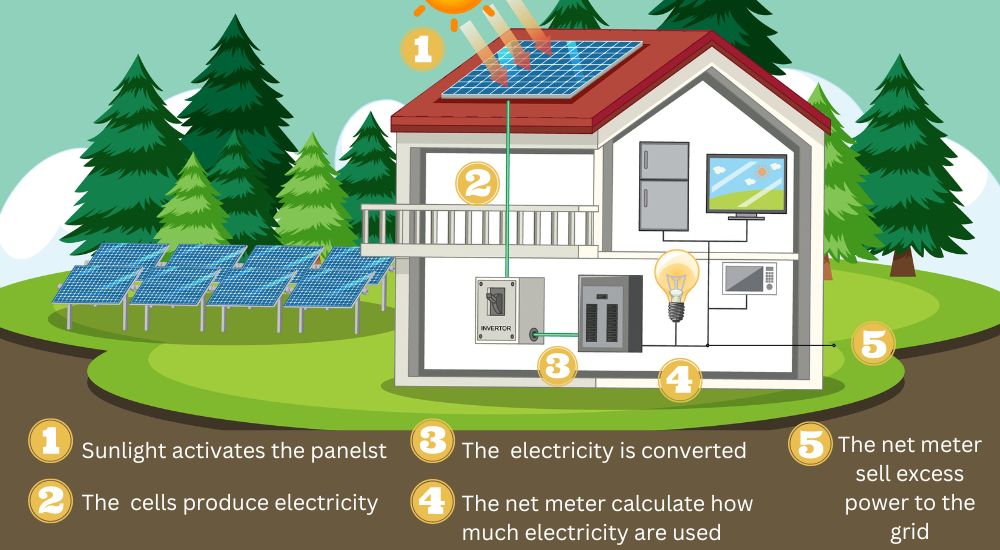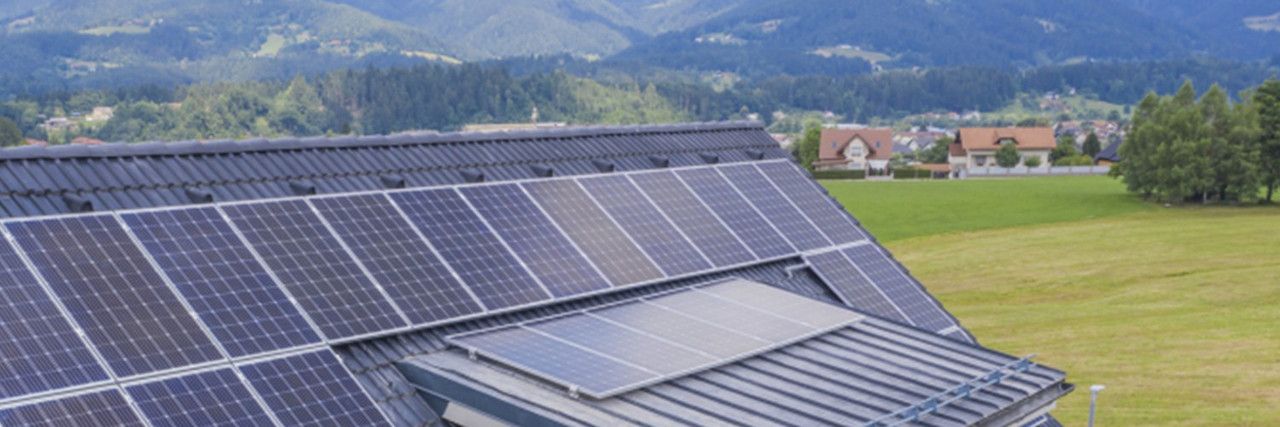How Does A Solar Panel Work On A House?
You might be interested in getting a solar panel system, but you would like to know exactly how they work before you make the leap. That’s smart, given that you and your family will be living in close proximity to these panels.
The good news is that solar panels are some of the safest energy generation devices on the planet. And because NASA has been using them since the 1960’s, we know all of the science behind them.
But that’s in space, of course. How does a solar panel work when it’s attached to your house? Let’s start by exploring the materials that make energy collection possible.
Table of contents:
- What Are Solar Panels Made Of?
- How Does A Solar Panel System Work?
- How Do Solar Panels Generate Electricity?
- How Do Solar Panels Work On A House?
- How Does A Solar Panel Work On A Caravan Or Camper Van?
- How Does Weather Affect Solar Energy?
- How Does A Solar Panel Work When It's Cloudy?
- Do Solar Panels Work At Night?
- How Can I Get Solar Panels?
What Are Solar Panels Made Of?
Although experimental solar panels are made from all sorts of things, the ones that you see on a daily basis are made from a fairly standard set of materials.

[The structure of one of Renogy's monocrystalline solar panels]
The outer frame of a solar panel is pretty simple: Metal, plastic, or occasionally rubber for some of the flexible models. This is just the container that holds everything else in place.
The surface panel is a clear glass or plastic with - and this is the important bit - anti-reflective coating. The panel is trying to let the sunlight through and absorb as much as possible. Anything reflected is a waste.
The solar cells are the actual workhorses here. Gallium or boron is weaved together with crystalline silicon and phosphorus to make a silicon ingot. Once these components are bound together they’re very chemically stable, so no worries there.
The wiring usually consists of thin strands of copper or gold, to carry the electricity out of the solar panel. These metals are particularly good at allowing electrons to pass through them.
How Does A Solar Panel System Work?
Albert Einstein won the Nobel Prize for figuring this out, but you get to learn the secret for free!
When a beam of sunlight passes through the surface panel and hits a solar cell, it pushes out an electron. This is called the photoelectric effect. As a semiconductor, Silicon is just acting as a medium that lets the energy of light break electron bonds so they can freely flow down a wire.
This is why energy producing solar panels are called photovoltaic, while panels dedicated to converting sunlight directly to heat are called solar thermal.
For more information, read How Does the Solar System Work..
How Do Solar Panels Generate Electricity?
One free electron can’t exactly power very much. So how do solar panels generate electricity in amounts that can actually matter?
Each solar cell has millions of microscopic locations where it can absorb light and generate the photoelectric effect. Multiply this effect across the entire surface area of a solar panel, and again across many solar panels, and you can create quite a bit of juice! So the system needs to be regulated somehow. Usually, that’s one of the many jobs that a solar inverter performs.
The primary function of a solar inverter is to turn this DC electricity flow into an AC electric wave that your appliances can use. If the solar panel system produces more energy than you need at the time, the excess DC flow might also be directed to a solar battery, to store it for later use. In some setups, any energy that would be wasted is automatically sold back to the electricity grid, making you a little bit of money and allowing someone else to make use of electricity that would have been wasted.
For a deeper dive into the industry, the US government’s Department of Energy has you covered. Or you can read our another article How Do Solar Panels Produce Energy.
How Do Solar Panels Work On A House?
When mounted on a house, solar panels are angled in the direction where they will catch the most sunlight possible throughout the day. So for example, in the northern hemisphere, solar panels will be angled in a somewhat southerly direction, catching as much light as possible as the sun passes from east to west.

[How does a solar panel work diagram]
High places, such as house roofs, are the normal choice for mounting solar panels. But garages, shaded garden or cropland (also known as agrisolar), and outbuildings are all candidates for solar panels.
The U.S. government’s National Renewable Energy Laboratory (NREL) site can help you track what we call ‘peak sun hours’. Assuming your solar panels are tilted correctly, peak sun hours are how you determine approximately how much energy you make on the average day.
For example: Let’s say you have a 4 kiloWatt solar array on your house. And in your part of the country you get 5 peak sun hours. That means you would produce around 20 kW hours worth of electricity on the average day. If you have a solar battery, some or all of that excess power will be stored for later use.
Peak sun hours are longer in the summer, and shorter in the winter, so you get more bang for your buck in May, June, July, and August. In November, December, January, and February you’ll be at your lowest energy production. But not to worry, you aren’t entirely off grid. If you don’t produce enough power for all of your activities, you’ll draw power from your electric company as normal.
All of this activity is captured by a solar meter. The meter commonly tells you how much solar you produced, how much you used or stored, how much got sold back to the grid, and how much energy you needed to draw from the grid that day.
How Does A Solar Panel Work On A Caravan Or Camper Van?
The story is similar for mobile solar installations. You generally want your panels to be mounted as high as possible, such as on a vehicle’s roof. You want a clear path to the sky, particularly to a south facing if you’re camping in the U.S. or Canada.
One difference with solar panels on a caravan or camper van is that you can also choose to have flexible solar panels. These can be strategically placed to catch the most possible sunlight, even in more difficult terrain.
You’re far more likely to want a solar battery when you’re on the road. Being able to run an appliance or two even when you’re off grid can be a life saver. Without the power company backing you up, whatever you generate in a day is your total power allowance. So you want to capture and store as much power as you can during peak sun hours.
How do you figure out the number of solar panels and the size of the battery that you need? Use a solar calculator to figure out how much power each of your appliances draws.
How Do Solar Panels Work - Frequently Asked Questions (FAQ)
How Does Weather Affect Solar Energy?
Anything that causes the sky to be dark or overcast will impact solar collection… but maybe not as much as you think. Solar can work off of every visible light frequency, so you’ll still get some power generation on gloomy days. But you will, of course, generate the most solar power on beautiful clear days.
How Does A Solar Panel Work When It’s Cloudy?
Clouds act as a mirror from the sun’s perspective, reflecting energy back out into space rather than letting it hit the ground. This is called the ‘albedo effect’. But any energy that passes through the cloud cover is still up for grabs. You’ll notice that a cloudy day is rarely as dark as actual nighttime, which means light is getting through. So the percentage of sunlight that does make it through the clouds can trigger the photovoltaic effect and make some electricity.
For more details, you can read Do Solar Panels Work on Cloudy Days.
Do Solar Panels Work At Night?
Normal solar panels don’t work at night. But scientists at Stanford University have figured out a way to use an experimental solar panel’s radiative cooling to generate a small amount of electricity at night. It might be enough to run an LED light bulb or partially charge a cell phone. Further studies are being conducted to see if there are broader applications.
How Can I Get Solar Panels?
The best way to get solar panels for your home or RV is to talk to experts who can suggest systems where all of the components work well together.
Renogy has a team of experts who can walk you through the entire solar panel buying and installation process. We can either ask you a few questions about your current electricity setup, or we can use the results of your solar calculator to suggest a great solar panel system for you.
Or you can have a look at some of the pre-selected solar power kits that are available. These particular components have been selected and grouped up because we knows that they all work together seamlessly. Once a base kit is selected, it can be expanded to increase the number of solar panels up to the maximum amount for that particular solar inverter. And you can select a 12V battery or 48 V battery for power storage.
Learn more about Renogy here, or contact us on their website for more information.
Related articles:
How Efficient Are Solar Panels: A Brief Guide
Building An Off-Grid Solar System With Your Child To Fight Climate Anxiety
Solar Panels For Camping: Everything You Need To Know








